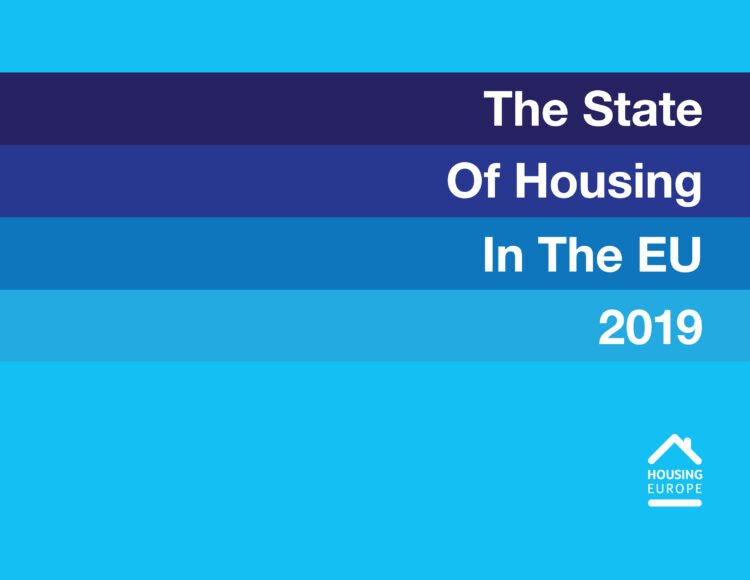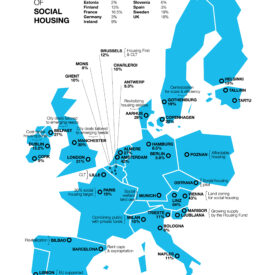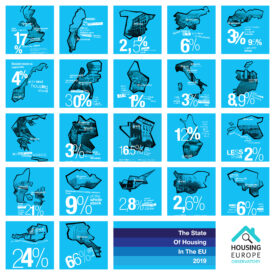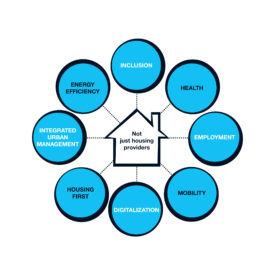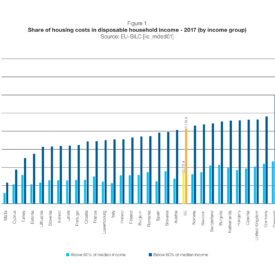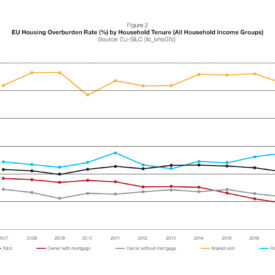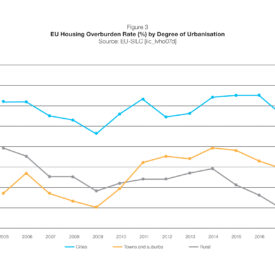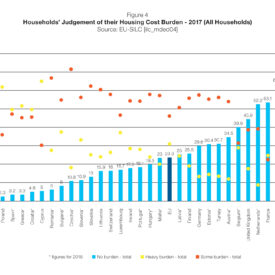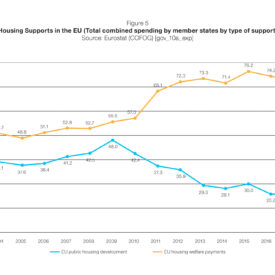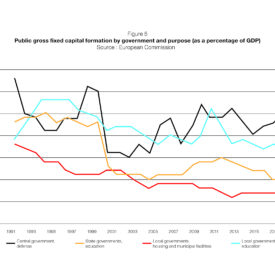The Housing Europe Observatory, the research branch of Housing Europe celebrates its 25th anniversary by presenting the latest edition of its flagship report ‘The State of Housing in the EU’ that has become over the last years the biennial compass of Europe’s housing sector. Here are in a nutshell the highlights of this unique report. Here are the highlights:
1. Addressing a structural problem with patchwork
Europe’s housing crisis, already identified in the 2015 and 2017 editions of the ‘State of Housing in the EU’ is still a reality many countries are confronted with. What we have seen, in the meantime, is that although this is clearly a structural problem- as the data below shows- it continues to be addressed by decision makers with a patchwork of, often costly, policy solutions.
While populations as a whole may not struggle to put a roof over their head, national statistics often hide huge differences in terms of how different income groups and geographic areas are impacted. In 2017, 10.2% of households in the EU spent over 40% of their disposable income on housing costs, but this share increases to 37.8% when considering households at risk of poverty. At the same time, when housing costs are taken into account, 156 million people are at risk of poverty, as against 85 million before housing costs are taken into account (EU SILC).
On top of that, while a 2018 study by the High-Level Task Force (HLTF) estimated that the investment gap in affordable housing stands at €57 billion per year, public investment in the sector that could boost the supply keeps falling. Instead, governments are often focusing on incentives to private developers while housing supports for low income households is increasingly being given in the form of social welfare type payments. Between 2009 and 2015, expenditure on housing allowances in the EU has increased from 54.5bn to 80.8bn Euros.
Nobody can argue against the necessity this social welfare support delivered via housing allowances that are essential for millions of Europeans but this should not prevent governments from addressing the structural problems causing the housing crisis, which additionally can lead to significant savings on the long term.
Read the full chapter ‘Trends in Housing Affordability’
Read the full chapter ‘Investment in affordable housing’
2. Housing and the alarming social divide
The housing question is at the heart of the growing social divide that we observe in most European societies over the last years. While accessing and sustaining decent accommodation is primarily an issue for those living on low incomes, more and more people are affected by the lack of affordable housing, particularly in big cities, and make their voice heard putting housing de facto on the political agenda.
Rising rents have mobilized thousands of people across Europe, while for the first time ever a European Citizens’ Initiative has been launched calling for more affordable housing in Europe.
Although attention is drawn to the need to reduce the energy consumption in our homes, energy poverty is affecting almost 50 million people in Europe and investment in better quality homes is slower than necessary, often for those who need it most, impacting also the public budgets allocated in health.
What has become also evident over the last couple of years is that housing has been used as part of the wider populist, anti-immigration agenda, making the link with the arrival of new populations and supply shortage across Europe while over-looking the pre-existing shortage and under-investment. This narrative has unfortunately hijacked the housing policy in many cases.
3. Cities at the forefront of the housing challenge
The role of cities in determining housing policies and ultimately housing conditions of their inhabitants has become a key policy topic in recent years. This is due on the one hand to increasing evidence showing that cities, in Europe and beyond, are the places where the shortage of affordable housing is mostly concentrated and on the other to a number of city-led policy initiatives in the field of housing.
The extent to which cities are active in tackling the housing shortage varies significantly. Exemplary cases are often to be found in a context where municipalities must respect targets on affordable housing delivery – as it is the case in France- and where devolution of powers and competences mean that the city administration can play an active role- with examples such as Vienna, Munich or Barcelona. However, lack of available land, NIMBYism, existing problems with spatial inequalities and segregation, in some cases a preference by local administration to use available land for more lucrative activities – ultimately simply lack of political will, prevent the implementation of local housing policies in many countries.
No matter which path cities are taking in the housing challenge crossroads, the lesson learnt over the last years is that the housing issue cannot be addressed with purely housing tools. Improvement of transport within city districts and between other agglomerations for instance can be used to reduce pressure. An integrated urban approach can provide with sustainable policy initiatives.
Read the full chapter ‘Changes in Governance- Cities facing the housing challenge’
4. Changes in housing delivery
The role of social and affordable housing providers continues to evolve, going beyond just housing provision reacting to changing needs.
Supported housing schemes helping households with economic and social difficulties to access and keep permanent housing are now a reality in France, Italy and Spain.
Housing providers deploy more and more partnerships with employment services to help residents get into work, as in the case of the French ‘Pack Emploi-Logement’.
Mobility and digitalization are also incorporated in the traditional public, cooperative and social housing models with providers putting in place car sharing platforms or e-platforms to access parking spots in Austria and installing chargers for electric cars in Norway and in Spain. At the same time, the housing selection experience is changing with tenants now having in many cases the option of a ‘virtual tour’ of the premises or even the possibility to swap social housing units using just an app, see for instance the Dutch ‘Huisjehuisje’.
Read the full chapter ‘Changes in housing delivery- An evolving role for social and affordable housing providers’
5. Housing, a priority for decision makers at Local, National and European level
No doubt, housing is a local issue and, as mentioned above, local authorities tend to take over bigger shares of responsibility. However, the national policies as well as the European agenda in multiple housing-related areas are more than ever intertwined with the local dimension. Social and affordable housing has been at the heart of the EU Urban Agenda. The EU is now aiming to implement effectively the “Housing and assistance to homeless people” part of the European Pillar of Social Rights. At the same time the EU internal market legal framework for affordable housing is impacting local and national housing policies. Could the future see the EU dedicating an investment fund to housing or excluding investments in social housing from the Stability Pact? It’s probably a matter of time…
Read the full chapter ‘Changes in EU Landscape- Social, cooperative and public housing’
Have a look at all 22 country profiles
We’d like to hear your views on social media! Share your thoughts and/or relevant work #housingeu and @housingeurope
For any question related to the report, please contact our Research Director, Alice Pittini. For any issue related to communication around the report, please contact our Communications Director, Diana Yordanova.
